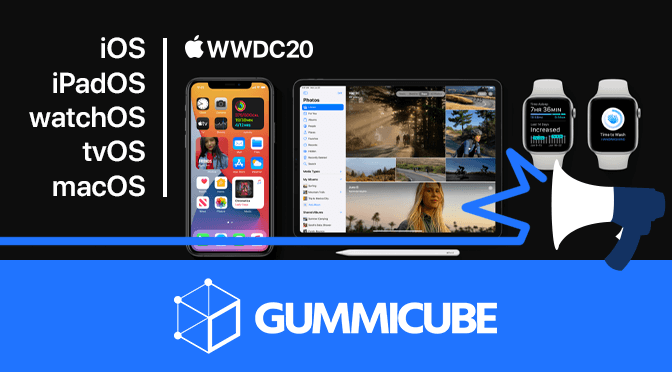WWDC 2020 Reveals iOS 14 and More
June 23rd, 2020


by David Bell
CEO at Gummicube, Inc.
Apple’s WWDC 2020 keynote presentation ended with several announcements, including new operating systems, app development tools and more. It’s time to look at the biggest news from the keynote and how it can impact App Store Optimization.
New OS
The biggest announcement was the announcement of iOS 14. Along with the new iOS, Apple also announced updates for iPadOS, watchOS and macOS.

iOS 14
The first announcement was the upcoming release of iOS 14. The announcement includes many new updates, including:
A new App Library that automatically organizes apps by category, suggestions, usage and so forth.
Reimagined widgets that can be adjusted in size and moved onto the home page.
Picture-in-picture video to let users open other apps without interrupting their videos.
Updated Messages features, including pinned messages and in-line replies to group chats.
Updated Maps app with improved Guides, cycling directions, EV routing options and more.
Updates to CarPlay, including digital car keys for unlocking and activating connected vehicles.
A new Translate app that provides voice-to-text translations, including a conversation mode.
Perhaps most important for app developers is the release of App Clips. App Clips are similar to Instant Apps, where users can instantly open a select part of an app without needing to install the full application.
App Clips are designed to help improve app discovery and usage. They can be launched from the phone through the web, messages or on Maps. Users can also hold their phones to NFC tags or scan QR codes to instantly launch App Clips.
The clips will instantly open to the part of the app users need, rather than installing and launching the app in its entirety. It is important to note that it has yet to be revealed how Clips will count towards engagement metrics in App Store Connect; we will learn more about that as App Clips roll out.
iPadOS 14
Along with iOS 14, Apple has updated iPadOS to match. iPadOS 14 includes the updates to iOS 14, as well as several iPad-specific changes, such as:
An updated Photos app with a new sidebar.
New Calendar controls.
Universal Search that can search apps, contacts, documents, features within apps, and web browsers from a single search interface.
New Apple Pencil features for straightening out lines, automatically converting handwriting to screen text.
watchOS 7
Apple also announced a new watchOS update. watchOS 7 adds the ability to create personalized watch faces that can provide multiple pieces of information, such as weather, reminders and health data.
App developers can include preconfigured watch faces with their Apple Watch apps. The App Store will also include lists of curated faces that users can download.
Additional watchOS 7 updates include:
Workouts updated for dances, including heart rate and gyroscopic data to determine the full range of movements and exercise.
Cycling directions added to Maps.
Automatic hand washing detection and a countdown to ensure you’ve washed for an effective amount of time.
Sleep tracking updates to help users wind down before going to bed with personalized routines and minimized distractions.
Desktop & Laptop
Along with mobile device updates, WWDC covered the latest improvements to Mac computers. This includes big changes for upcoming products, as well as a new operating system.
macOS Big Sur
Apple’s latest macOS was revealed and named: Big Sur. This includes several upgrades to the operating system and user interface, including:
A new design with a top to bottom sidebar.
Customizable widgets.
Updated Mail and Photos applications.
New developer capabilities like menu and keyboard APIs.
New Catalyst port of its Developers App to help developers bring iOS apps to Mac.
Automatic translations on Safari.
Apple Silicon
Mac computers will also be transitioning to new Apple Silicon chips. These are designed to be energy efficient while still offering a high performance, with scalable architecture that includes advanced power management, high performance GPU, neural engines and more.
There’s a focus on tight integration of Silicon with software. Apple’s native apps will be updated for Big Sur and Apple Silicon to be ready for customers on day 1. App developers can also use a new version of Xcode to recompile their apps for Apple Silicon within days and build computer apps for Intel and Apple Silicon with a single binary through Universal 2.
Existing apps can be translated to work on new Macs with Apple Silicon through Rosetta 2. This translates the apps at install time and includes dynamic translation for JITs.
Apple will continue to sell Intel-based Macs as it makes this transition over the next two years and promises to continue supporting them, but developers should prepare for the change.
Developers can apply for the Universal App Quick Start Program to begin preparing and optimizing for Apple Silicon and macOS Big Sur. This includes Developer Transition Kit hardware, documentation, support, and the beta versions of Big Sur and Xcode 12.
Apple Silicon brings Apple into the computer chip vertical, alongside companies like Intel, Samsung and Toshiba.
Privacy
A major concern in technology is security. Users want their data to be safe, and Apple is working hard to ensure that it can be.
Users are now given more control over their location data, including the option to share approximate locations instead of exact. Similarly, a new policy will require apps to ask before tracking at all times, providing users with more control over where, when and how they’re tracked.

Apple is also updating its privacy policy. Developers must inform Apple what user data their apps gain access to, if they’re sharing it and with who.
That information is then added to the App Store listing as an easy to view section near the bottom of the page, so users can see at a glance how their data is used. This could have an impact on conversions for apps that may require accessing user information.
And More
The two-hour keynote included announcements of all kinds. Additional information from Apple includes:
tvOS 14 will allow for picture-in-picture views, improved AirPlay sharing and workout tracking.
A new TV+ show based on Isaac Asimov’s “Foundation” novels.
Smart Home interoperability standards, developed in a partnership with Google, Amazon and other industry leaders.
Automated suggestions, visual statuses, adaptive lighting and facial recognition for Smart Home technology.
AirPod updates to instantly switch between devices and provide directional audio.
WWDC 2020 is underway with sessions, discussions and more throughout the coming days, but there’s already much to be excited for. Developer betas for the new operating systems are available today, with public betas due next month before the updates go live this Fall.
Want more information regarding App Store Optimization? Contact Gummicube and we’ll help get your strategy started.
Similar Articles

Posted on September 16th, 2020
The latest Apple event, “Time Flies,” has concluded. The live streamed event introduced us to upcoming devices and services, as well as announced the launch date for the new operating systems. True to predictions, the iPhone 12 was not announced, but there is still plenty of news app developers will want to be aware of.

Posted on September 12th, 2020
The yearly Apple Event has been announced, which means the latest in iOS devices and services will be revealed soon. The event, titled “Time Flies,” will reveal new hardware and services, although recent announcements around delayed devices raise questions about the specifics. With that in mind, here’s what we can expect at Apple’s “Time Flies” event.

Posted on June 20th, 2020
WWDC, Apple’s annual event, is quickly approaching. While the event is normally an in-person and streamed experience, it has moved entirely online for digital events.







